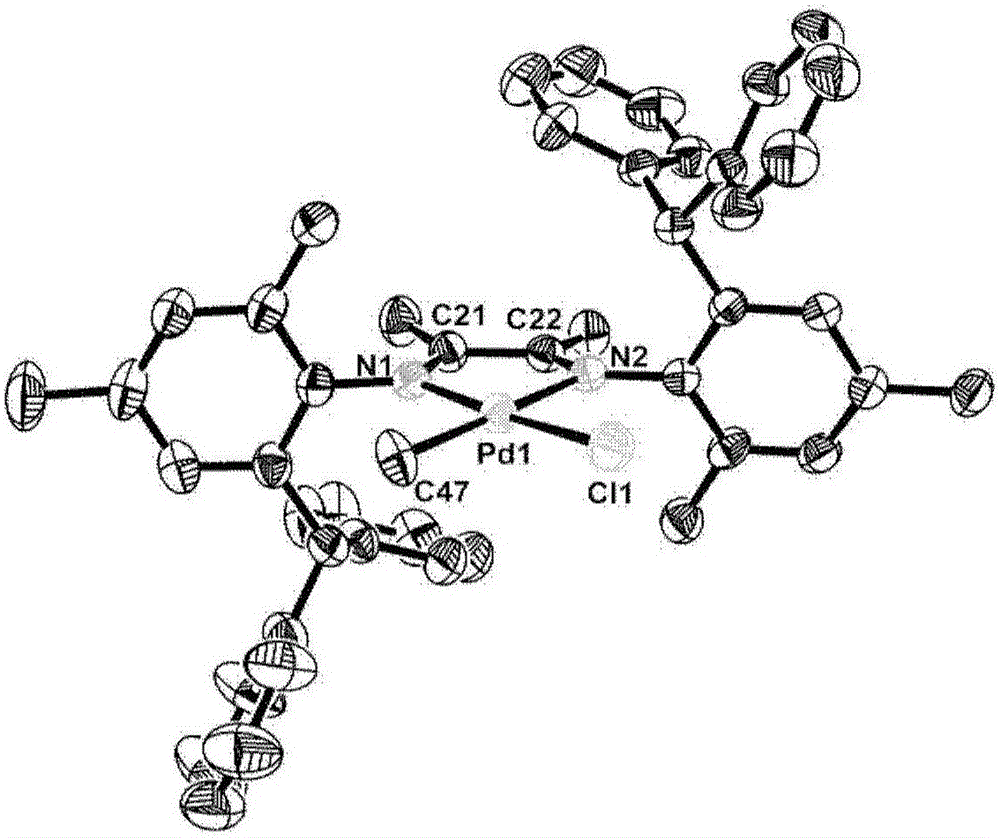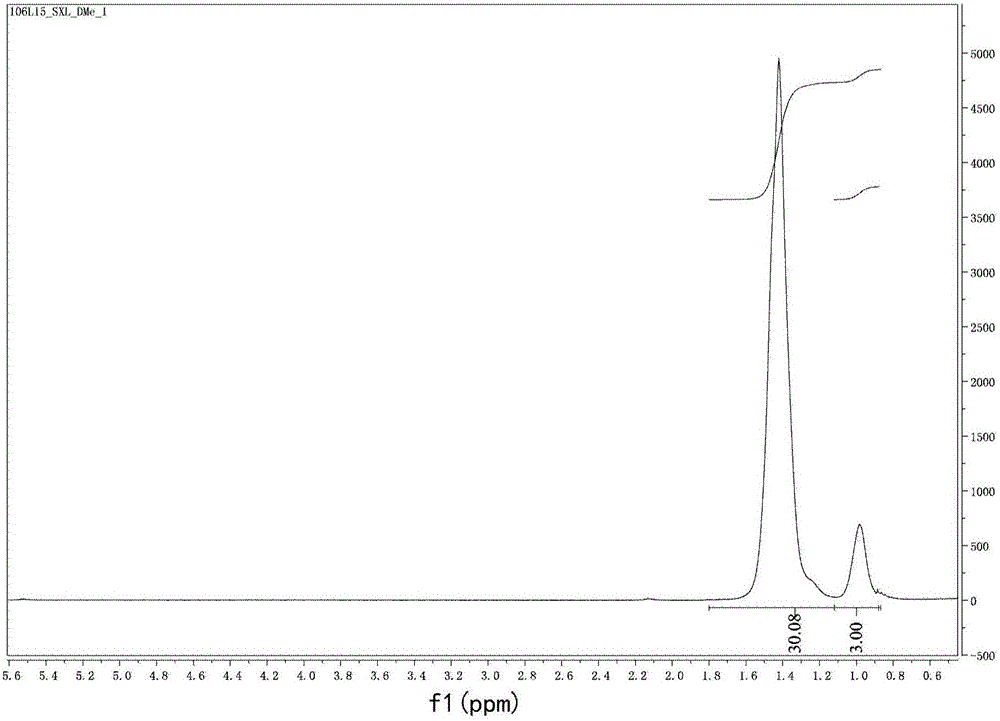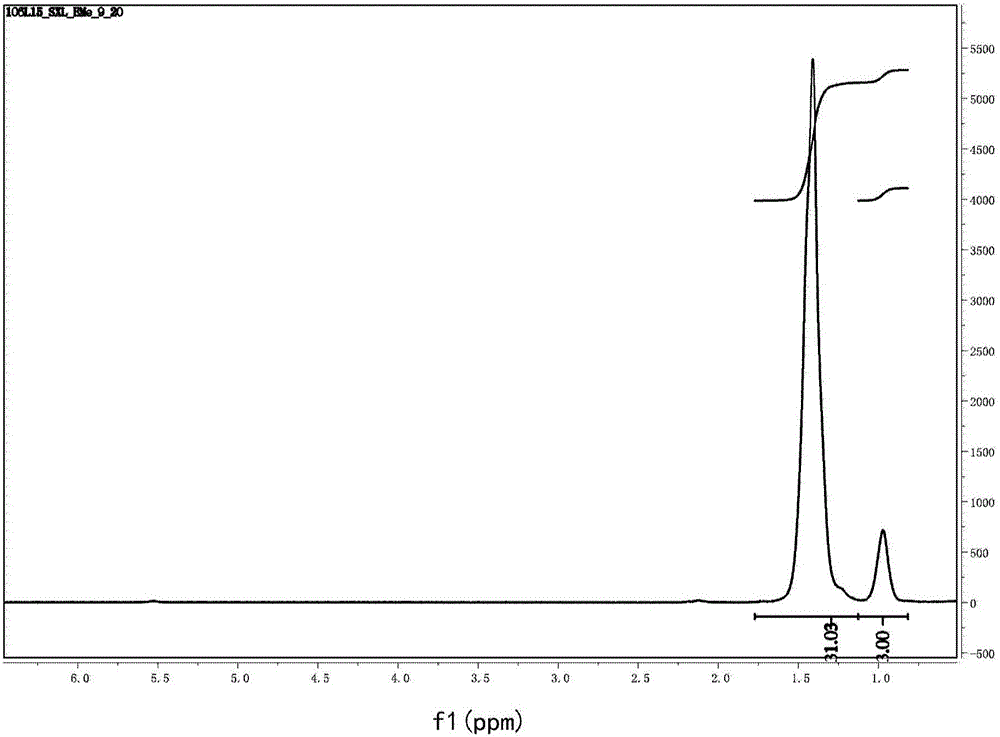Asymmetric diimine palladium catalyst and ligand, preparation method and application thereof
A technology of compounds and complexes, applied in the preparation of imino compounds, chemical instruments and methods, palladium organic compounds, etc., can solve the problems of low branching degree, narrow molecular weight distribution, inconvenient processing, etc.
- Summary
- Abstract
- Description
- Claims
- Application Information
AI Technical Summary
Problems solved by technology
Method used
Image
Examples
Embodiment 1
[0072] Embodiment 1: N, the synthesis of N-two (2-benzhydryl-4-methoxy-6-methylphenyl) butane-2,3-diimine
[0073]
[0074] At room temperature, add 8.41 grams of 2-benzhydryl-4-methoxy-6-methylaniline, butyl 0.86 g of diketone and 20 mg of p-toluenesulfonic acid were heated to 80° C. in an oil bath to react for 24 hours. Then, divide the water and reflux for three days with a water separator (Sinwell 14-port water separator), and use petroleum ether and dichloromethane 1: 1 to spot the plate, and you will find that there is mainly one point, indicating that the reaction has ended. Finally, part of the solvent was removed by rotary evaporation, and then 300 ml of methanol was added to the remaining reaction solution, and a large amount of yellow solid was precipitated. The solid was obtained by filtration under reduced pressure, washed three times with 20 mL of methanol, and dried in vacuo to obtain 8.23 g of solid with a yield of 85%.
[0075] 1 H NMR (400MHz, CDCl 3...
Embodiment 2
[0076] Embodiment 2: N, the synthesis of N-two (2-benzhydryl-4-chloro-6-methylphenyl) butane-2,3-diimine
[0077]
[0078] Similar to Example 1, at room temperature, 8.61 grams of 2-benzhydryl-4-chloro-6-methylaniline, 0.86 grams of diacetyl and p-methyl 20 milligrams of benzenesulfonic acid, and heated to 80 ℃ by oil bath for 24 hours to react, then use a water separator (Xinweier 14 port) to divert water and reflux for seven days, and use petroleum ether and dichloromethane 1: 1 point board to find that mainly A dot, indicating that the reaction has ended. Part of the solvent was removed by rotary evaporation, and then 300 ml of methanol was added to the remaining reaction solution, and a large amount of yellow solid was precipitated. The solid was obtained by filtering under reduced pressure with a water pump, washed three times with 20 ml of methanol, and dried in vacuo to obtain 8.22 g of a solid with a yield of 81%.
[0079] 1 H NMR (400MHz, CDCl 3 )δ7.27 (d, J=1....
Embodiment 3
[0080] Example 3: Synthesis of N,N-bis(2-benzhydryl-4-trifluoromethyl-6-methylphenyl)butane-2,3-diimine
[0081]
[0082] Similar to Example 1, at room temperature, 9.01 grams of 2,6-benzhydryl-4-trifluoromethylaniline, 0.86 grams of diacetyl and p-methyl 20 mg of benzenesulfonic acid was heated to 80°C in an oil bath to react for 24 hours, and then refluxed and separated for seven days with a water separator (Xinwell 14 port). With petroleum ether and dichloromethane 1: 1, it was found that mainly a dot, indicating that the reaction has ended. Part of the solvent was removed by rotary evaporation, and then 300 ml of methanol was added to the remaining reaction solution, and a large amount of yellow solid was precipitated. The solid was obtained by filtration under reduced pressure, washed three times with 20 mL of methanol, and dried in vacuo to obtain 4.03 g of solid with a yield of 50%.
[0083] 1 H NMR (400MHz, CDCl 3 )δ8.06, 8.04 (d, J=2.1Hz, 2H, aryl-H), 7.75, 7.6...
PUM
 Login to View More
Login to View More Abstract
Description
Claims
Application Information
 Login to View More
Login to View More - R&D
- Intellectual Property
- Life Sciences
- Materials
- Tech Scout
- Unparalleled Data Quality
- Higher Quality Content
- 60% Fewer Hallucinations
Browse by: Latest US Patents, China's latest patents, Technical Efficacy Thesaurus, Application Domain, Technology Topic, Popular Technical Reports.
© 2025 PatSnap. All rights reserved.Legal|Privacy policy|Modern Slavery Act Transparency Statement|Sitemap|About US| Contact US: help@patsnap.com



